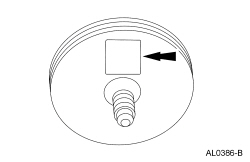
219-00074 or equivalent

219-00024 or equivalent
SECTION 412-00: Climate Control System — General Information and Diagnostics
| 2014 Mustang Workshop Manual
|
GENERAL PROCEDURES
| Procedure revision date: 01/07/2013
|
 | A/C Flush Adapter Kit
219-00074 or equivalent |
 | A/C Flush and Purge Fitting Kit
219-00024 or equivalent |
| Item | Specification |
|---|---|
| Motorcraft® PAG Refrigerant Compressor Oil
YN-12-D | WSH-M1C231-B |
NOTICE: An Air Conditioning (A/C) refrigerant analyzer must be used before the recovery of any vehicle's A/C refrigerant. Failure to do so puts the shop's bulk refrigerant at risk of contamination. If the vehicle's A/C refrigerant is contaminated, refer the customer to the service facility that carried out the last A/C service. If the customer wishes to pay the additional cost, use the A/C recovery equipment that is designated for recovering contaminated A/C refrigerant. All contaminated A/C refrigerant must be disposed of as hazardous waste. For all equipment, follow the equipment manufacturer's procedures and instructions.
NOTICE: On vehicles being serviced for an internal compressor or desiccant failure, a new suction accumulator or receiver/drier, Thermostatic Expansion Valve (TXV) or evaporator core orifice and any hoses containing mufflers must be installed prior to filtering the Air Conditioning (A/C) system. Internal plumbing of these devices makes it impossible to correctly remove any foreign material. These components are typically discarded after A/C system contamination. Hoses without mufflers can normally be reused unless they are clogged with foreign material. The filter is intended for use on one vehicle only.
NOTE: The filter inlet is marked with a label on one side of the filter body.
Orient the filter inlet toward the A/C condenser core.
NOTICE: The flexible extension adapters included in the A/C Flush Adapter Kit are designed for low-pressure flushing and are not designed for use with a charged refrigerant system. Do not make the condenser fitting connections using the flexible extension adapters or damage to the adapters and loss of refrigerant will occur.
NOTE: The F8VZ-19E773-AB pancake filter is not permanently installed and will be removed at the end of this procedure.
Disconnect the condenser outlet fitting and temporarily install the pancake filter between the 2 halves of the fitting.